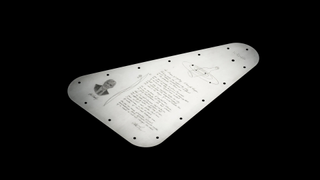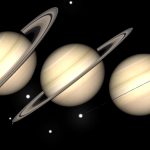Key takeaways:
- NASA’s Europa Clipper mission will carry a silicon microchip with over 2.6 million names stenciled onto it, part of the “Message in a Bottle” campaign.
- Alongside the names, the spacecraft will include a commemorative plate featuring a handwritten poem, “In Praise of Mystery: A Poem for Europa,” by US Poet Laureate Ada Limón.
- The commemorative plate, made of tantalum, measures 7 by 11 inches and includes artwork that highlights Earth’s connection to Europa, with waveforms and radio frequencies symbolizing communication and water.
- Scheduled to launch in October 2024 and arrive at Jupiter by 2030, the Europa Clipper will perform 49 flybys of Europa to study its subsurface ocean, icy crust, and thin atmosphere.
- While Europa is a prime candidate for finding alien life, new data from NASA’s Juno mission suggests it may lack enough oxygen. The Europa Clipper will provide further insights into this possibility.
From a poem composed by a US Poet Laureate to millions of stenciled names, NASA’s Clipper spacecraft’s journey to Europa will be personalized.

NASA has revealed a mysterious human message that will be sent on its newest mission to Jupiter’s frozen ocean moon, Europa.
In 2023, the space agency started a campaign dubbed “Message in a Bottle,” in which millions of people signed their names to a message that would be delivered throughout the solar system onboard the Europa Clipper. The launch is set for October 2024 and is part of a study to determine if places underneath Europa’s icy surface may host life.
In a statement issued March 8, NASA disclosed how these names will be taken into space. The Microdevices Laboratory at NASA’s Jet Propulsion Laboratory stenciled over 2.6 million names onto a “dime-size” silicon microchip. This microchip will be mounted to a commemorative plate that will have a handwritten copy of Ada Limón’s poem “In Praise of Mystery: A Poem for Europa” as well as other design features.
The plate, which measures around 7 by 11 inches (18 by 28 centimeters) and is made of the metal tantalum, will be covered on both sides with artwork that “highlights Earth’s connection to Europa,” NASA said in a statement. If any life is discovered on Europa, it is more likely microbiological, therefore the commemorative plate serves as a symbolic gesture rather than a genuine communication to extraterrestrial life forms.
“The content and design of Europa Clipper’s vault plate are swimming with meaning,” Lori Glaze, head of NASA’s Planetary Science Division, said in a release.
“The plate integrates the finest of humanity’s contributions to the cosmos, including science, technology, education, art, and math. The concept of connectivity through water, which is necessary for all kinds of life as we know it, wonderfully symbolizes Earth’s link to the unknown underwater realm we are about to discover.”
The elaborate pattern of the plate pays attention to this scientific quest as well as the ties between Earth and Europa. The outward-facing panel, for example, includes waveforms, which are graphic representations of sound waves created from recordings of individuals speaking the word “water” in 103 languages. The plate’s inward-facing side includes graphic references to radio frequencies that might be utilized for intergalactic communication.
“We’ve packed a lot of thought and inspiration into this plate design, as we have into the mission itself,” Robert Pappalardo, a project scientist at NASA’s Jet Propulsion Laboratory, said in a statement. “It’s been a decade-long journey, and we can’t wait to see what Europa Clipper discovers in this ocean world.

“After traveling 1.8 billion miles across space, Clipper is projected to begin circling Jupiter in 2030. From there, it is anticipated to perform 49 close flybys of Europa. Scientists want to use the mission to collect data on the subsurface of Europa’s ocean, which holds twice the amount of water as all of Earth’s seas, as well as data from the moon’s icy crust, thin atmosphere, and outer space.
The moon has long been regarded as one of the most promising possibilities in the quest for alien life; however, newly revealed data from NASA’s Juno mission reveals Europa may lack adequate oxygen to support life, crushing these expectations. The Europa Clipper’s forthcoming observations will assist to answer this question.


